HP hpe6-a48 practice test
Aruba Certified Mobility Expert 8
Question 1
A bank deploys an Aruba Mobility Master (MM)-Mobility Controller (MC) solution to provide wireless
access for users that run different applications on their laptops, including SIP-based IP telephony.
When users only run the IP telephony software, call quality is high. However, if users also run email,
web, or mission critical applications, then voice quality drops.
Which feature would help improve the quality of voice calls over the air when users run different
applications?
- A. DSCP for IPv4 traffic
- B. WiFi Multi Media
- C. Type of Service
- D. High/Low Queue
Answer:
A
Question 2
A point venture between two companies results in a fully functional WLAN Aruba solution. The
network administrator uses the following script to integrate the WLAN solution with two radius
servers, radius1 and radius2.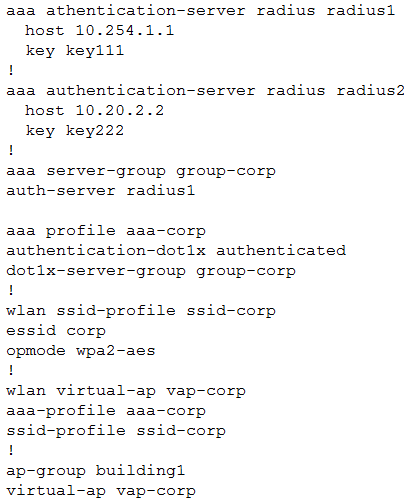
While all users authenticate with [email protected] type of credentials, radius1 has user
accounts without the domain name portion.
Which additional configuration is required to authenticate corp1.com users with radius1 and corp2
users with radius2?
- A. aaa authentication-server radius radius1 trim-fqdn ! aaa server-group-corp auth-server radius1 match-authstring corp1.com auth-server radius1 match-authstring corp2.com
- B. aaa server-group-corp auth-server radius1 match-fqdn corp1.com auth-server radius1 trim-fqdn auth-server radius2 match-fqdn corp2.com
- C. aaa authentication-server tadius radius1 ! aaa server-group-corp auth-server radius1 match-string corp1.com trim-fqdn auth-server radius1 match-string corp2.com
- D. aaa authentication-server radius radius1 trim-fqdn ! aaa server-group-corp auth-server radius1 match-domain corp1.com auth-server radius1 match-domain corp2.com
Answer:
B
Question 3
A network administrator implements a SIP-based IP telephone solution. The objective is to ensure
that APs use 100% of their airtime for network access whenever a voice call is taking place, to
minimize communication delays. The network administrator also wants to ensure that a log entry is
generated when voice calls occur.
Which setup accomplishes these tasks?
- A. ip access-list session voice user any svc-rtsp permit log queue high user any svc-sip-udp permit log queue high
- B. ip access-list session voice user any-svc-rtsp permit disable-scanning log user any svc-sip-udp permit disable-scanning log
- C. ip access-list session voice user any svc-rtsp permit log dot1p-priority 7 user any svc-sip-udp permit log dot1p-priority 7
- D. ip access-list session voice user any svc-rtsp permit log tos 56 user any svc-sip-udp permit log tos 56
Answer:
B
Question 4
Refer to the exhibits.
Exhibit1
Exhibit2
A network administrator integrates a current Mobility Master (MM)-Mobility Controller (MC)
deployment with a RADIUS infrastructure. After using the RADIUS server to authenticate a wireless
user, the network administrator realizes that the client machine is not falling into the it_department
role, as shown in the exhibits.
Which configuration is required to map the users into the proper role, based on standard attributes
returned by the RADIUS server in the Access Accept message?
- A. aaa server-group Corp-Network set role condition Filter-Id equals it-role set-value it_department
- B. aaa server-group GROUP-RADIUS set role condition Filter-Id equals it-role set-value it_department
- C. aaa server-group Corp-employee set role condition Filter-Id equals it-role set-value it_department
- D. aaa server-group Corp-employee set role condition Filter-Id value-of
Answer:
B
Question 5
Refer to the exhibits.
Exhibit 1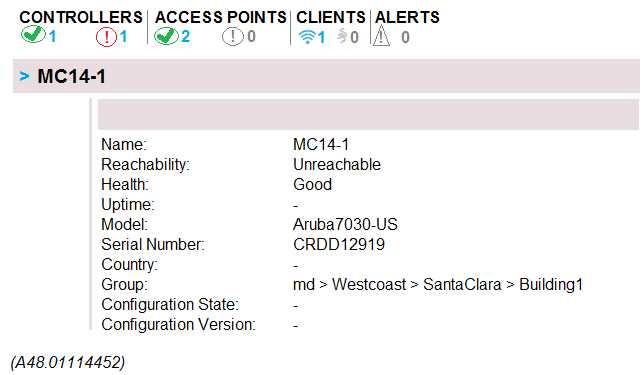
Exhibit 2
A network administrator adds a new Mobility Controller (MC) to the production Mobility Master
(MM) and deploys APs that start broadcasting the employees SSID in the West wing of the building.
Suddenly, the employed report client disconnects.
When accessing the MM the network administrator notices that the MC is unreachable, then
proceeds to access the MC’s console and obtains the outputs shown in the exhibits.
What should the network administrator do next to solve the current problem?
- A. Decommission the MC from the MM, and add it again.
- B. Open a TAC case, and send the output of tar crash.
- C. Verify the license pools in the MM.
- D. Kill two zombie processes, then reboot the MC.
Answer:
D
Question 6
Refer to the exhibit.
A network administrator adds a Mobility Controller (MC) in the /mm level and notices that the
device does not show up in the managed networks hierarchy. The network administrator accesses
the CLI, executes the show switches command, and obtains the output shown in the exhibit.
What is the reason that the MC does not appear as a managed device in the hierarchy?
- A. The network administrator added the device using the wrong Pre=shared Key (PSK).
- B. The digital certificate of the MC is not trusted by the MM.
- C. The IP address of the MC does not match the one that was defined in the MM.
- D. The network administrator has not moved the device into a group yet.
Answer:
B
Question 7
Refer to the exhibit.
A 7008 Branch Office Controller (BOC) is deployed in a remote office behind a core router. This core
router does not support 802.1q encapsulation. The Mobility Controller (MC) is the gateway for two
tunneling mode SSIDs, as shown in the exhibit.
Which two different configuration options ensure that wireless users are able to reach the branch
network through the router? (Select two.)
- A. Configure all ports of the BOC as access ports on the controller VLAN, and change the gateway of clients to the core router IP.
- B. Configure the uplink of the BOC as an access port on the controller VLAN, and enable NAT for the SSID VLANs.
- C. Configure the uplink of the BOC as a trunk port, tagging the controller and the SSID VLANs, and enable NAT for the SSID VLANs.
- D. Configure the uplink of the BOC as an access port on the controller VLAN, and add static router in the router for the SSID VLAN subnets.
- E. Configure the uplink of the BOC as a trunk port that permits the controller and the SSID VLANs. The controller VLAN must be native.
Answer:
BD
Question 8
Refer to the exhibit.
A user reports show response time to a network administrator and suggests that there might be a
problem with the WLAN. The user’s laptop supports 802.11n in the 2.4 GHz band only. The network
administrator finds the user on the Mobility Master (MM) and reviews the output shown in the
exhibit.
What can the network administrator conclude after analyzing the data?
- A. Client health is low, and retried frames are high. It is possible there is high channel utilization.
- B. Client health is low, but SNR is high. It is possible data in the dashboard is not accurate and needs to be updated.
- C. The speed is good. Client health seems to be related to a problem with the client NIC.
- D. The network is low because of low SNR. TX power must be increased in both the client and the AP.
Answer:
B
Question 9
A customer with a multi-controller network upgrades the ArubaOS from 6.4 to 8. The customer’s
clients must be able to move between different locations of the campus without disconnecting their
applications, when roaming or if there are Mobility Controller (MC) failures. The customer also wants
to have full control of the users, and be able to change their session properties from a RADIUS server.
Which steps must the network consultant include in the implementation plan to meet these
requirements?
- A. 1. Create a controller cluster profile that contains the management and VRRP IP addresses of each member. 2. Apply the profile to all MCs in the cluster. 3. Confirm that the cluster is L2 connected.
- B. 1. Configure a VRRP instance for all MCs 2. Create a controller cluster profile that contains the management IP and VIP addresses of each MC. 3. Apply the profile to all MCs in the cluster. 4. Confirm that the cluster is L2 connected.
- C. 1. Configure a VRRP instance for each MC. 2. Create a controller cluster profile that contains the management IP of each member. 3. Apply the profile to all MCs in the cluster. 4. Confirm that the cluster is L3 connected.
- D. 1. Create a controller cluster profile that contains the management and VRRP IP addresses of each member. 2. Apply the profile to the cluster leader. 3. Confirm that the cluster is L2 connected.
Answer:
D
Question 10
Refer to the exhibit.
A network administrator deploys DSCP based prioritization in the entire wired network to improve
voice quality for a SIP-based IP telephony system used by the company. However, users report that
calls they make from the WLAN have poor audio quality, while desktop phones do not experience the
same problem. The network administrator makes a test call and looks in the datapath session table.
Based on the output shown in the exhibit, what is one area that the network administrator should
focus on?
- A. wireless network congestion
- B. WMM support on the WLAN
- C. UCC based DSCP correction
- D. wired network congestion
Answer:
D
Question 11
Refer to the exhibit.
A network engineer deploys two different DHCP pools in an Instant AP (IAP) cluster for WLANs that
will have connectivity to a remote site using Aruba IPSec.
Based on the output shown in the exhibit, which IAP-VPN DHCP modes are being used?
- A. distributed L3 and centralized L3
- B. distributed L3 and local L3
- C. distributed L3 and centralized L2
- D. local L3 and centralized L2
Answer:
C
Question 12
Refer to the exhibits.
Exhibit1
Exhibit 2
Based on outputs shown in the exhibits, what is the reason that AP12 is seen by two different
controllers?
- A. AP12 connects to a high availability group. MC1 is the active controller, and MC11 is the standby controller.
- B. AP12 is a multizone AP. MC1 is part of the primary zone, and MC11 is part of the datazone.
- C. AP12 connects to an MC cluster. MC1 is the A-AAC, and MC2 is S-AAC.
- D. AP12 is in the middle of the boot process. MC1 is the master IP controller, and MC11 is the LMS IP controller.
Answer:
B
Question 13
Refer to the exhibit.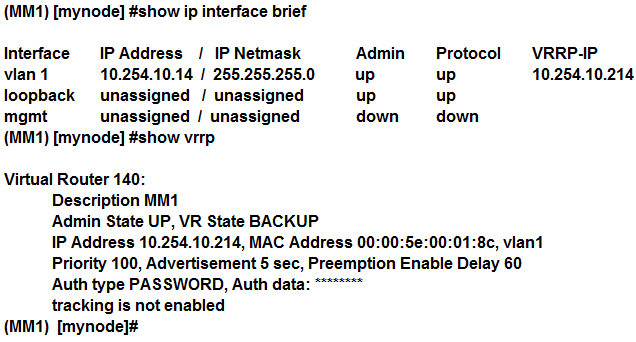
After a recent power outage where MM1 is located, the network administrator could not perform
configuration tasks on Mobility Controllers (MC) for several hours. The network administrator
decides to acquire another Mobility Master (MM) and deploy L2 MM redundancy. The new MM is
assigned the 10.254.10.15 IP address and VRRP is configured in both units. The network
administrator verifies that VRRP is running, and prepares to complete the setup with the following
scripts.
Which configuration tasks must the network administrator do before applying the script in order to
successfully deploy L2 MM redundancy and prevent any other control plane outage?
- A. Confirm that the VRRP and master redundancy keys are the same.
- B. Change the VIP address of ther VRRP process 140 to 10.254.10.15.
- C. Reduce the VRRP priority to 90 and restart the process in MM2.
- D. Enable the MM database synchronization in MM2.
Answer:
A
Question 14
Company 1 and Company 2 are medium-sized companies that collaborate in a joint venture. Each
company owns a building, and each has their own ArubaOS 8 Mobility Master (MM)-Mobility
Controller (MC) deployment. The buildings are located in front of one another. For the initial stage of
the project, the companies want to interconnect their networks with fiber, and broadcast each
other’s SSIDs.
These are the requirements:
Do not unify the company’s network management responsibilities.
Allow each company to take care of their own SSID setups when broadcasted in the other building.
Terminate Company 1 user traffic on Company 1 MCs when they connect to Company 2 APs.
Terminate Company 2 user traffic on Company 2 MCs when they connect to Company 1 APs.
What is needed to meet the solution requirements?
- A. Multizone APs
- B. Inter MC S2S Ipsec tunnels
- C. Multi MC Clusters
- D. Inter MC GRE tunnels
Answer:
B
Question 15
Refer to the exhibits.
Exhibit 1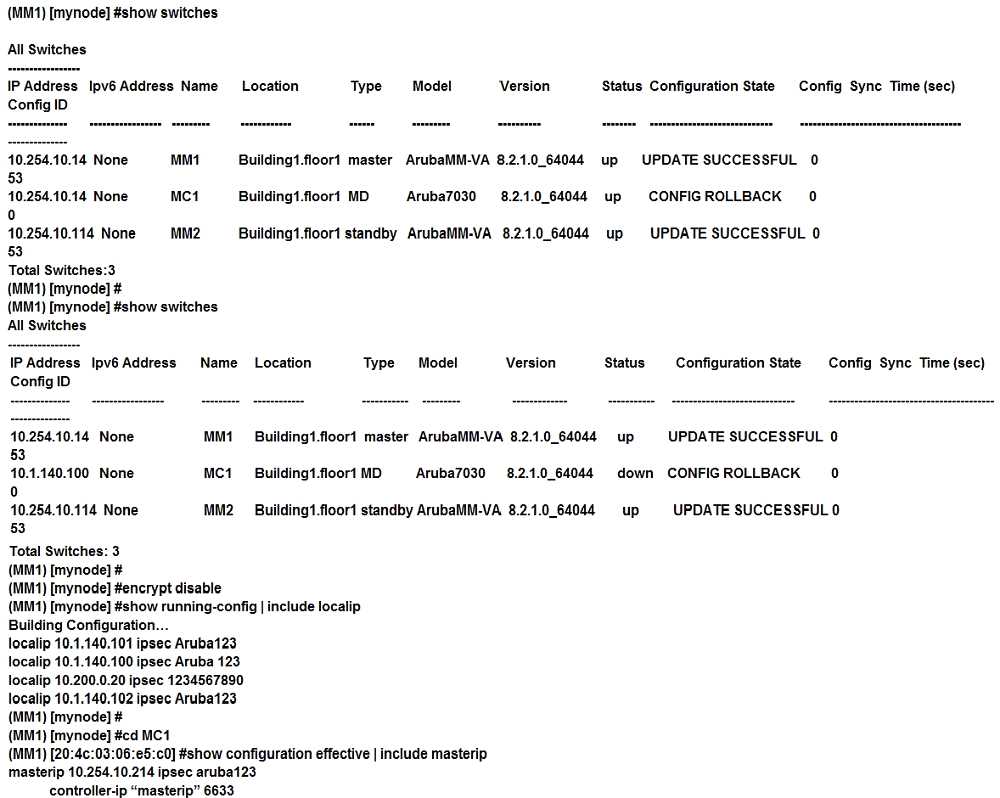
Exhibit 2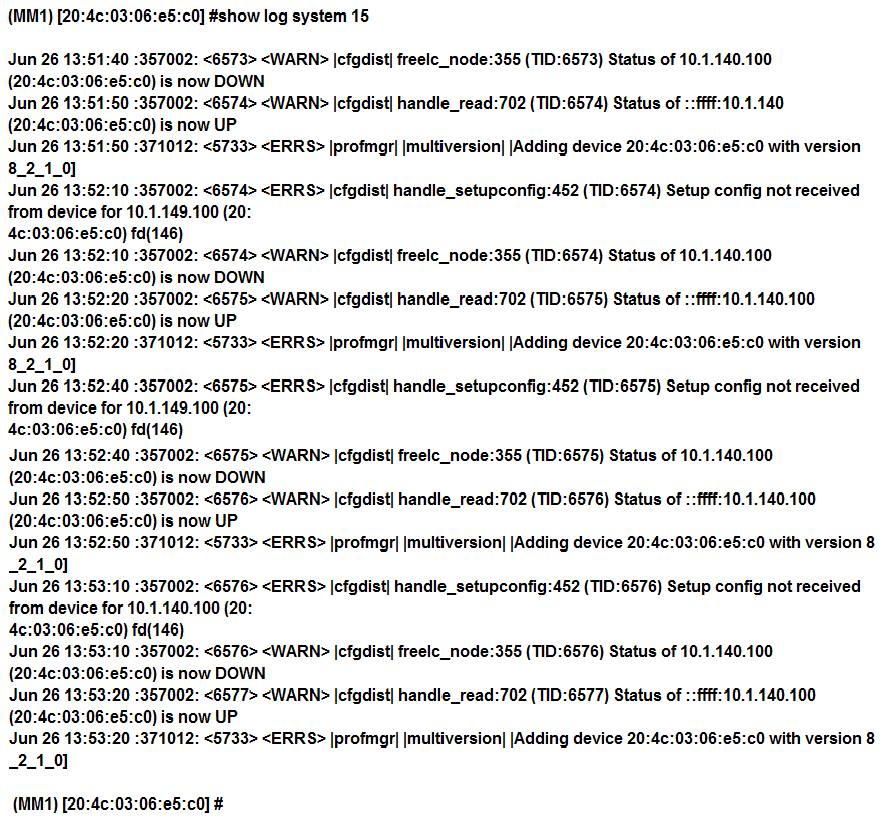
Exhibit 3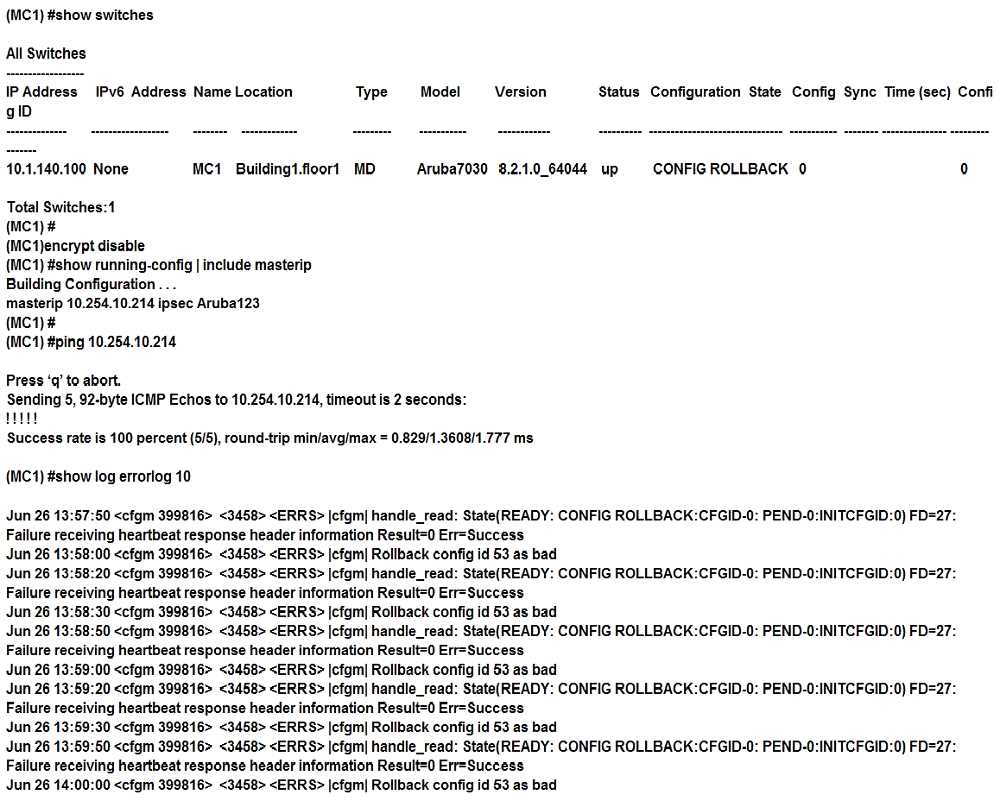
A network administrator deploys a Mobility Master (MM) pair with the VRRP VIP equal to
10.254.10.214, and attempts to associate MC1 to it. At first, the integration appears to be successful.
However after a few minutes the network administrator issues the show switches command and
sees that the MC1 is down, even though the device is up and running.
Every time the network administrator reboots the Mobility Controller (MC), the MC shows as being
up and then it shows as being down. The network administrator gathers the information shown in
the exhibits.
What should the network administrator do to resolve this problem?
- A. Change the localip ipsec key to Aruba123 in the mynode device level from the MM, save, and reboot.
- B. Enable disaster recovery mode in MC1 and change the masterip ipsec key to Aruba 123, save, and reboot.
- C. Change the masterip ipsec key to Aruba123 in the device level from the MM, save, then reboot MC1.
- D. Wipe out the configuration in MC1 and reboot, then run the full-setup configuration dialog all over again.
Answer:
B